We surveyed nearly 1,000 small business employees and discovered the “new normal” of work life after COVID-19 is familiar in some ways, but unexpected in others.
About once a decade, something happens that shakes up the status quo of the U.S. workforce. The Great Recession in 2008 led to what we now know as the “gig economy.” More recently, the 2010s saw businesses having to adapt to a new generation of workers: Generation Z.
And in 2021, businesses will have to deal with the aftermath of a shake-up we know all too well: the COVID-19 pandemic.
In the wake of COVID-19, businesses—especially small businesses—will confront a new normal. Employee needs and priorities have changed. Some talent management problems have been alleviated, while others have been made worse.
To better understand how COVID-19 has affected the future of work, Capterra surveyed nearly 1,000 small business employees in the U.S. From this data, we found five workforce trends that will have a significant impact on small businesses in 2021 and beyond.
If you’re a small business owner or manager, read on to learn what these trends are, and how you can work within them to maintain a productive and engaged workforce.
Trend #1: Employees are staying put
What’s happening?
Before the pandemic, employees were quitting their jobs more and more. Here’s a chart showing the percent of the U.S. workforce who voluntarily left their job every year from 2011 to 2019:
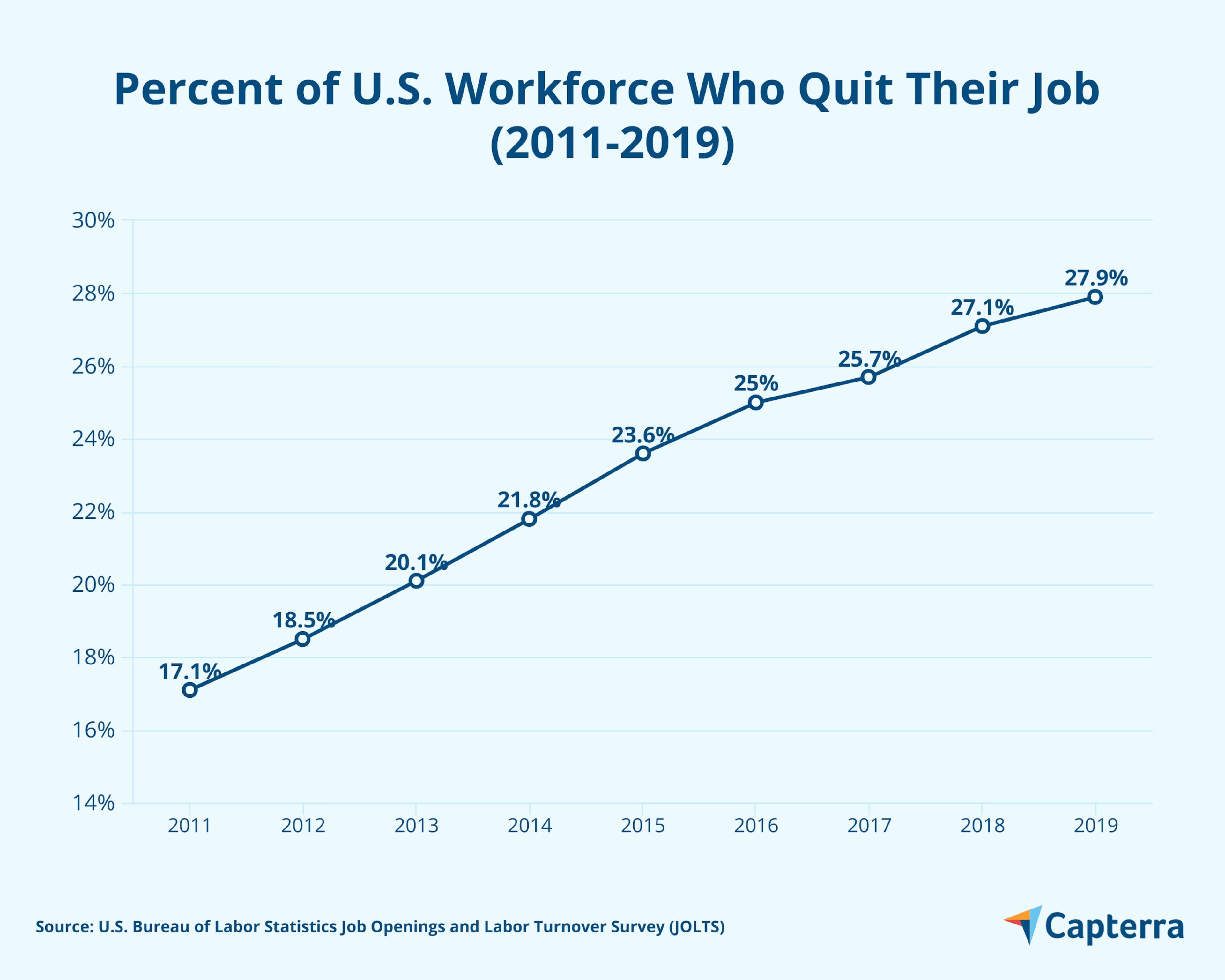
A difference of 11% over eight years may not seem like much, but remember, this chart represents around 160 million workers in the U.S. One percent is 1.6 million people!
So, why was this happening? The sheer amount of jobs, for one thing. The number of job openings reached a record high of 7.3 million by 2019. Compensation was another. Dealing with stagnant wages in their current job, workers discovered they had better chances of upping their pay by going somewhere else. (I wrote more about why employees were quitting so much here: “Why Employees Quit Their Jobs at Small Businesses”).
Now, here’s that same chart with 2020 tacked on:
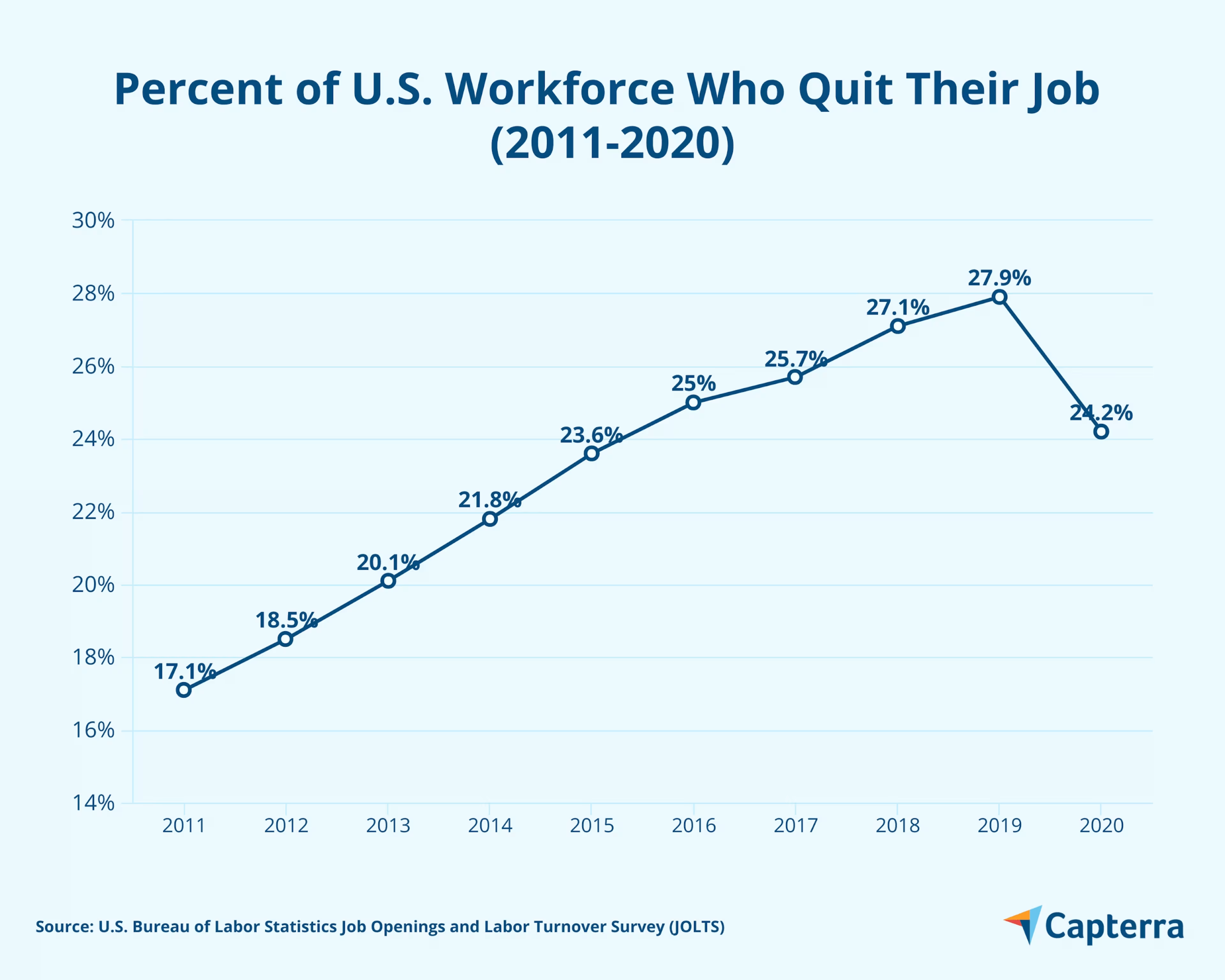
That drop-off in 2020? That’s COVID-19. As the economy took a downturn and job openings dried up, workers that were able to avoid layoffs decided to stay put. The result was the lowest number of employees quitting their job in the U.S. in five years, and a sharp reversal of a quitting trend that would’ve surely continued without a pandemic.
But here’s the kicker: Employees plan to stay put for a while. That’s according to our survey, where only 25% of small business employees say they plan to leave the job they have now when the pandemic is over.
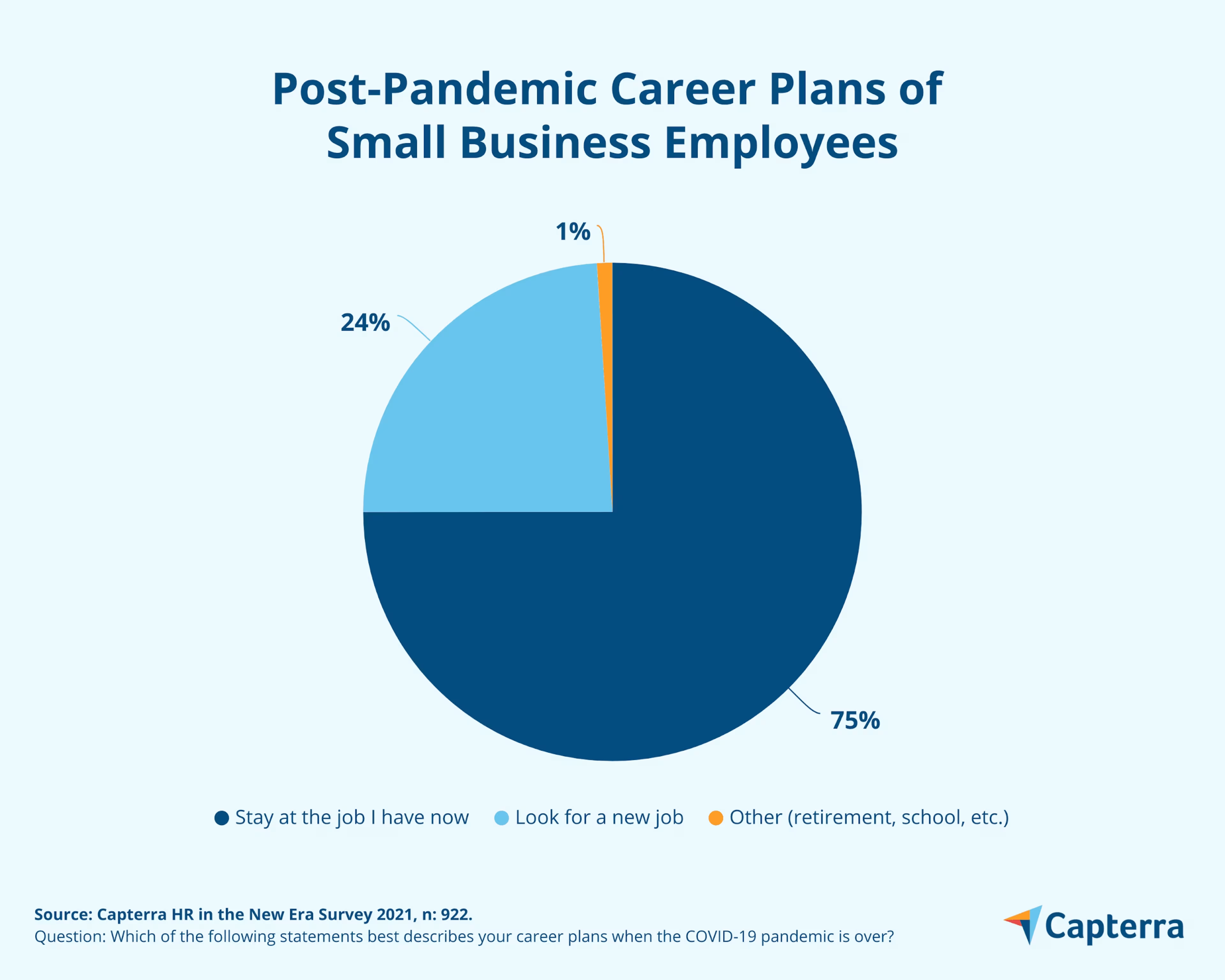
The dwindling job market is playing a role here, surely, but we also learned small business employees simply like where they are. In fact, 84% of small business employees in the U.S. say the COVID-19 pandemic made them like their job and employer about the same or more than before the pandemic. Only 16% say they like their job and employer less.
With small businesses set to enjoy retention levels they haven’t seen in years, they need to take advantage.
What small businesses should do now
You know all those big talent management projects you keep putting off because you’re not sure if your employees will stick around long enough to make them worthwhile? With signs that employees won’t be quite as eager to move around for the foreseeable future, now is the time to take a look at those long-term projects again. Projects like:
Learning and development: Invest in learning resources and systems to get your employee learning & development (L&D) program off the ground. (Learn why “It’s Time for Small Businesses to Take Charge of Upskilling Their Workforce”).
Succession planning: Who are the leaders of tomorrow in your organization? Identify those lower-level employees that show promise, then work with them to define their career goals, connect them with mentors, and come up with a plan to move up in the company. (For more on how to succession plan, read “Businesses Need to Do Better at Developing Their Managers”).
HR digital transformation: Businesses that digitize and make decisions based on hard data are better set up for long-term growth and success. To that end, if you’re still using paper files and spreadsheets to manage your workforce, now is the time to modernize. (Not sure if you’re ready for such a leap? Check out “Is Your Business Ready for an HR Digital Transformation?”).
Even if employee turnover only goes down slightly in your business, holding on to even one valuable employee that would’ve left the company otherwise can provide massive benefits if you invest in their long-term success.
Trend #2: Working from home isn’t going anywhere
What’s happening?
Before the pandemic, only 7% of small business employees in the U.S. in our survey were working from home. When COVID-19 hit, that number jumped to 37%. Another way to read this: A lot of workers who had never worked from home before suddenly got a taste of the experience last year.
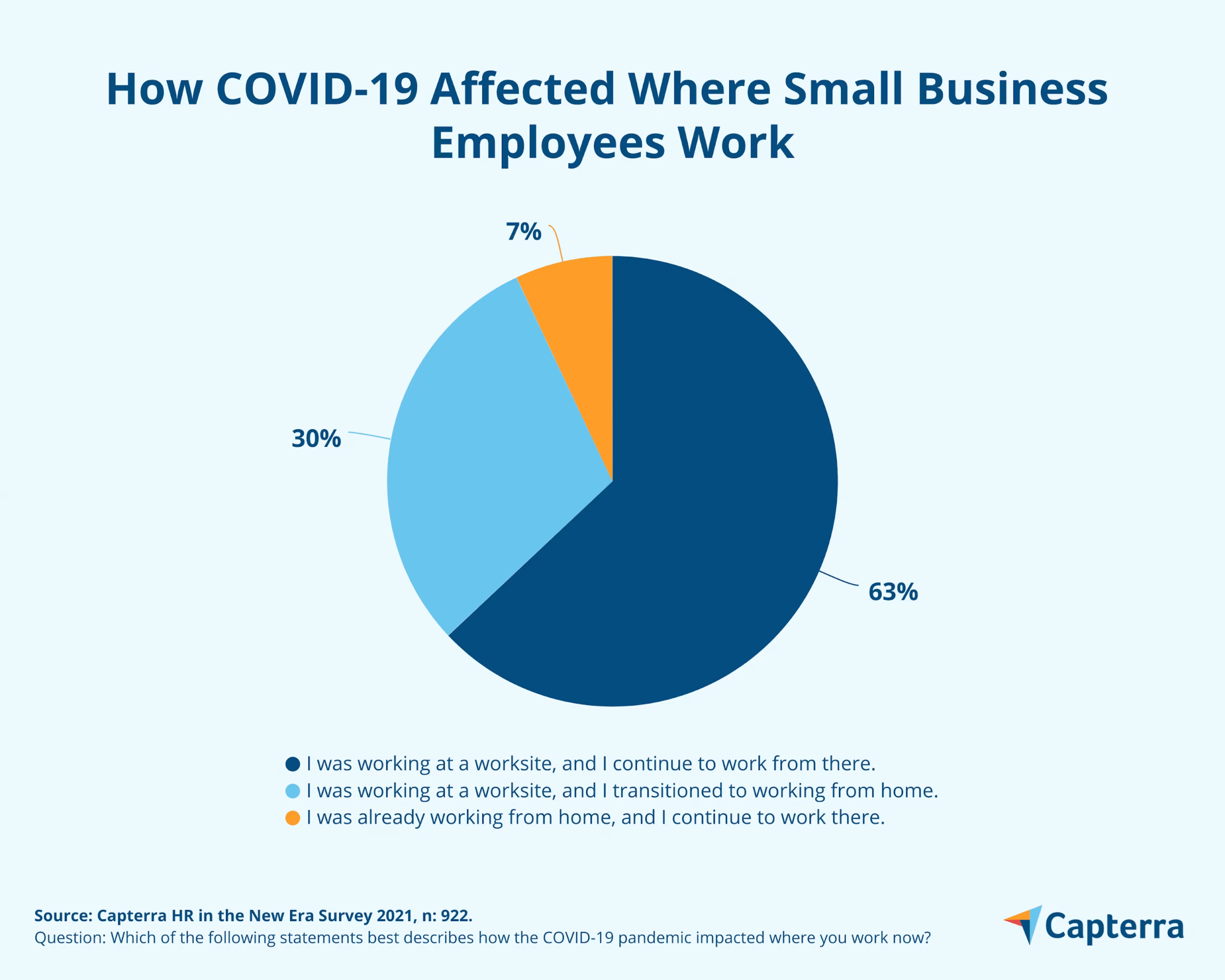
They liked what they saw.
In fact, the small business employees we surveyed have liked working from home so much during the pandemic that an overwhelming majority of those that made the working-from-home transition last year (86%) say they’d prefer to work from home at least some of the time when the pandemic is over. Nearly three in four (74%) would prefer to work from home at least half of the time. These numbers were similar across all age groups and living situations.
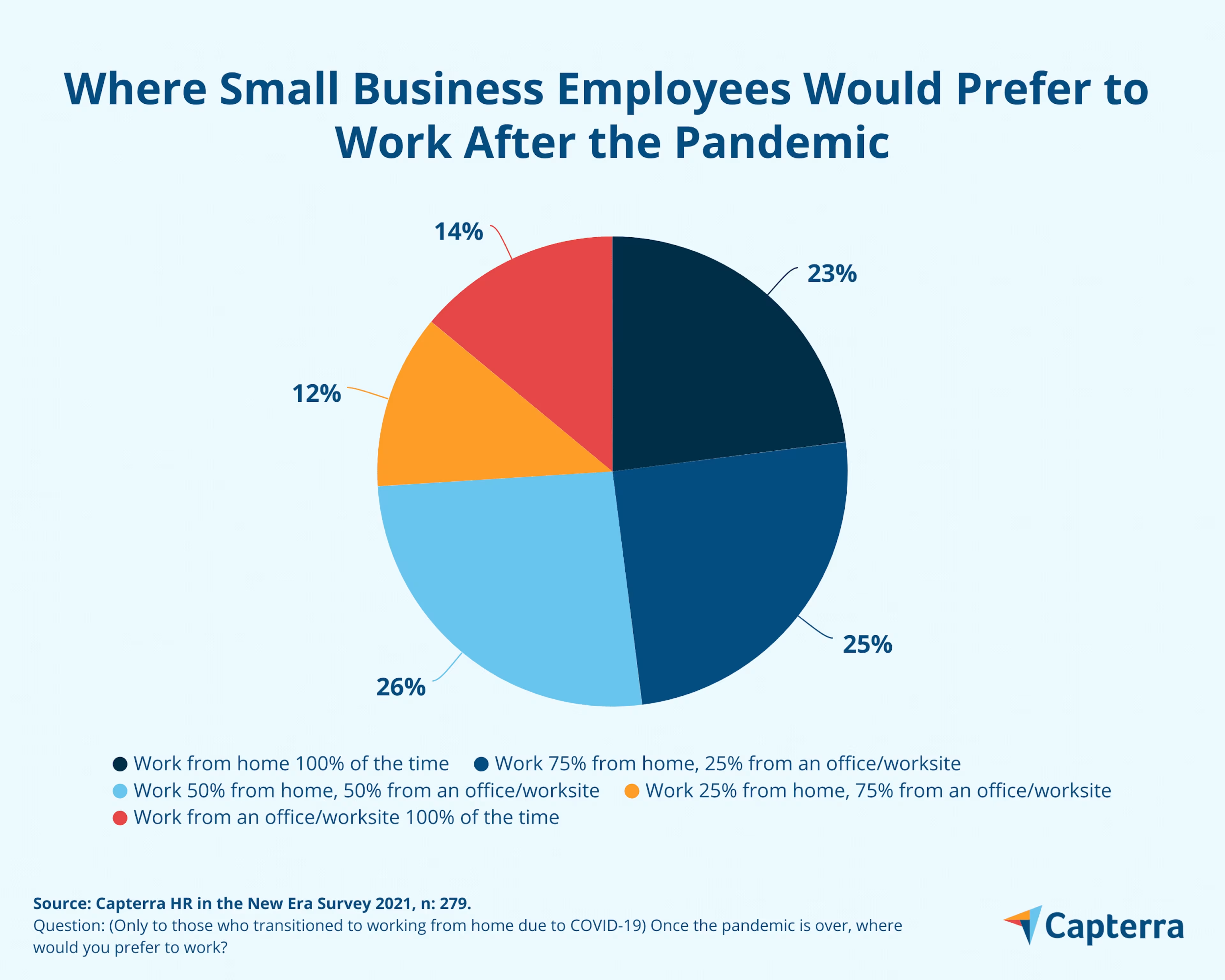
The preference to work from home full-time has only grown as well. In June 2020, 17% of those working from home due to COVID-19 said they’d want to work from home permanently when the pandemic is over. By January 2021, as the chart above shows, that number was 23%.
23%. Nearly one in four. That’s not just significant in the U.S. We sent our survey to small business employees in eight other countries around the world, and the U.S. had the highest percentage wanting to work from home full-time among them.
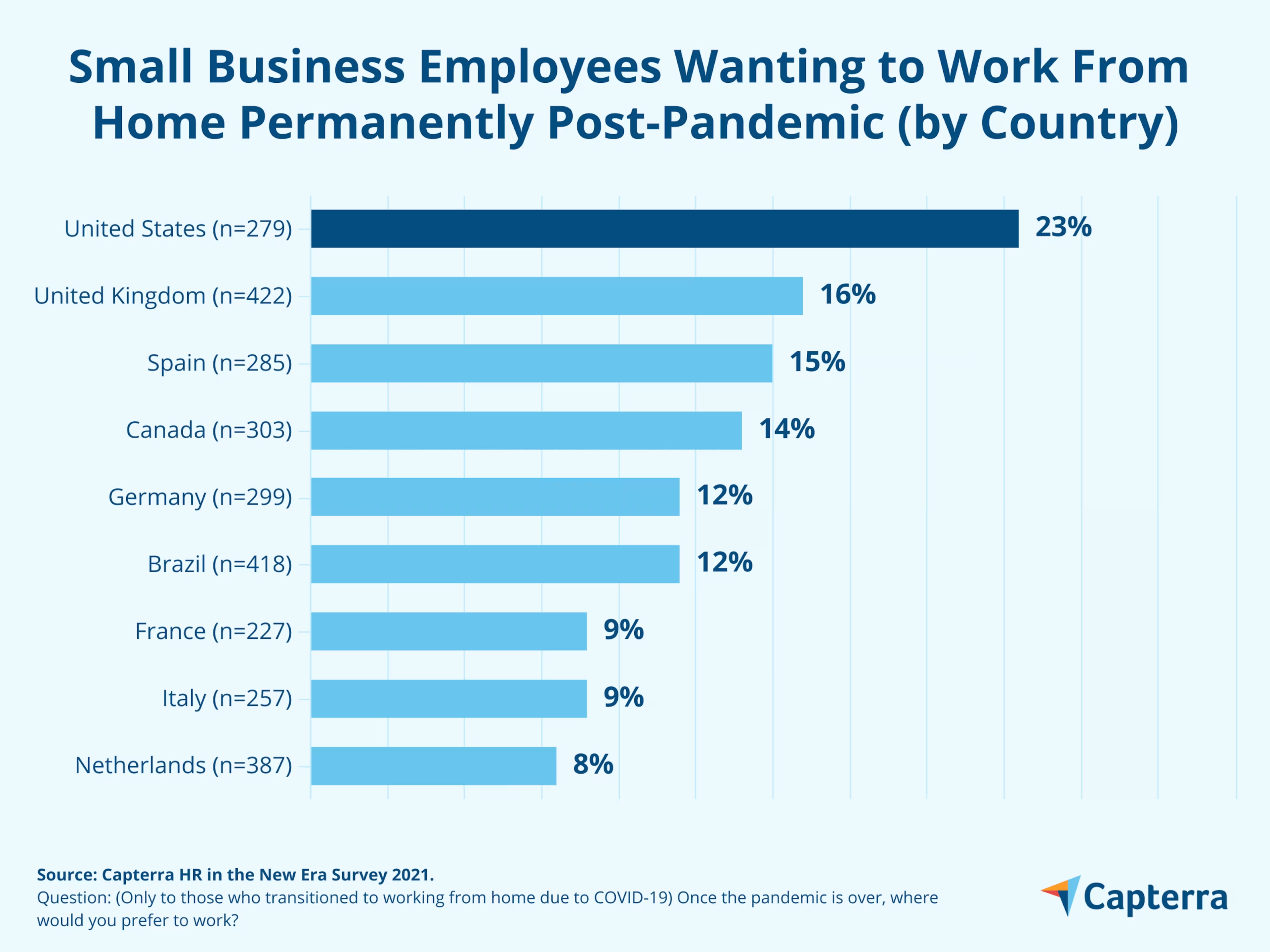
When it comes to working from home, the genie can’t be put back in the bottle. Small businesses will need to adapt to a new reality where the ability to work from home isn’t just a nice perk, but an expectation.
What small businesses should do now
In order to attract and retain top talent moving forward, small businesses will need to implement a flexible work-from-home policy for those employees that can work remotely—even when it’s safe to return to an office or other worksite. If you were one of those businesses rushing at the beginning of the pandemic to slap together a workable policy, now is the time to put in a more permanent and sustainable plan.
Here are some tips:
Finalize the “do’s” and “don'ts” of your work from home policy. If you only want employees to work from home a set amount of days per week, or require them to be in the office for certain meetings or tasks, figure out those rules now so workers have a clear understanding of what is and isn’t allowed.
Reexamine how remote employees are being managed. As most managers learned in 2020, managing remote employees comes with its fair share of unique challenges. Managers need to take a hard look at how they’re treating these workers. To that end, learn how to effectively manage remote teams in three steps, and how to make remote employees feel included as part of the team.
Review your remote work technology stack. If you’ve had a hard time maintaining the collaboration and engagement with your remote workforce you desire with the software you have, it could be time to upgrade. Learn which types of systems are vital to support remote work policies with “5 Software Systems for Effective Remote Working,” If you’re on a tight budget, check out our guide to the top free remote work software systems.
Trend #3: Burnout has gotten worse
What’s happening?
Though the transition to working from home has been a welcome one, it hasn’t solved a pervasive talent management issue: employee burnout. If anything, the transition has made it worse.
Defined by the World Health Organization (WHO) as a syndrome resulting from “chronic workplace stress that has not been successfully managed,” burnout can result in lower productivity and engagement, and higher turnover. In early 2020, Gallup found that 76% of employees experience burnout at least some of the time.
A year later, 77% of small business employees in the U.S. that transitioned to working from home due to the pandemic tell us they’re still experiencing at least some burnout. For global context, only Italy reported more small business employees suffering from burnout in our survey.
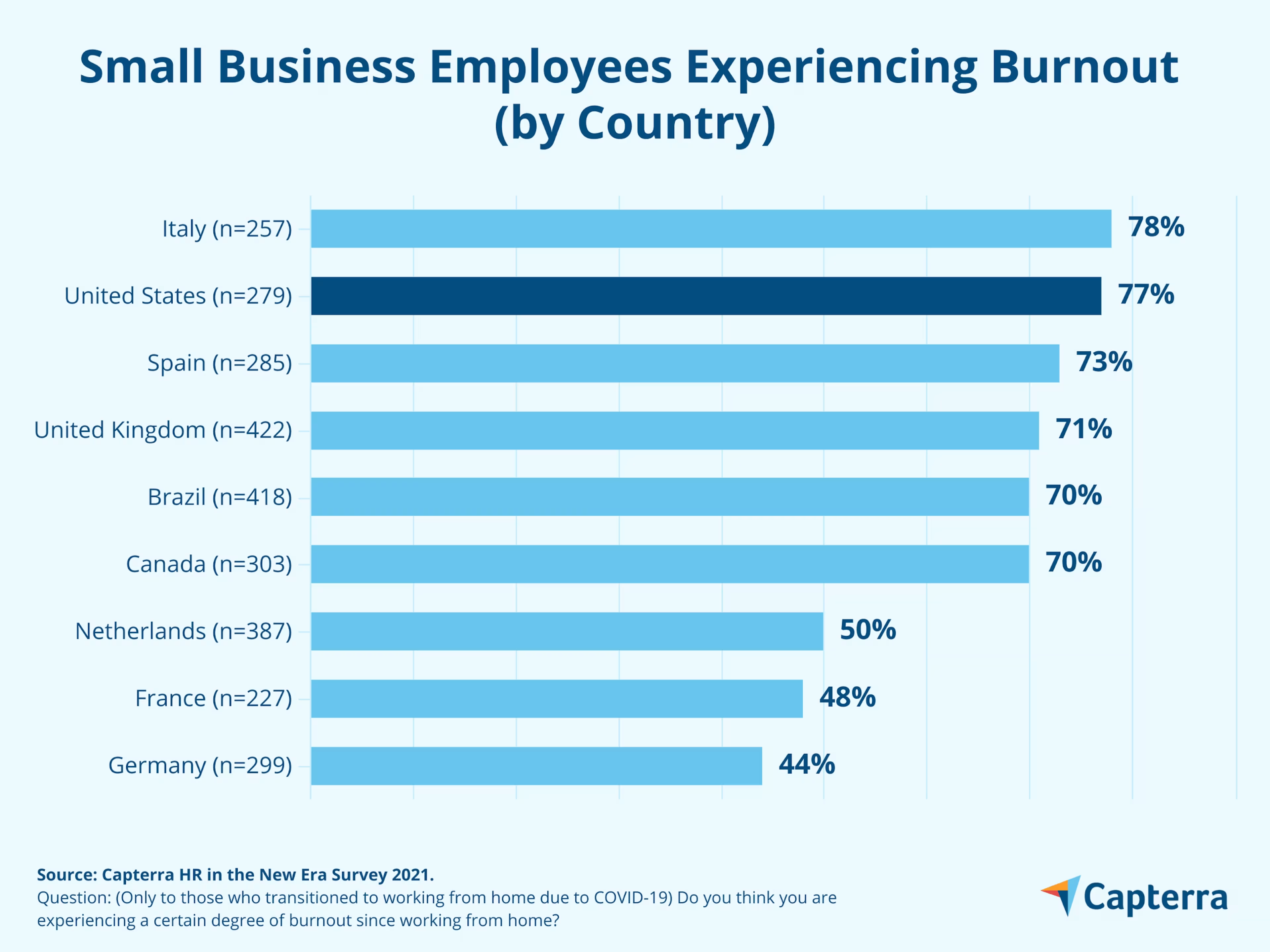
Burnout is especially prominent among younger workers. Here’s the percent of small business employees in the U.S. reporting burnout by age group:
Age Group | Burnout % |
18-25 (n=147) | 92% |
26-35 (n=200) | 88% |
36-45 (n=268) | 77% |
46-55 (n=164) | 58% |
56-65 (n=143) | 61% |
What’s causing this? Looking back at our report on employee burnout from 2019, we see the top cause of burnout according to those who experience it is working late hours or on weekends.
And that’s exactly what is happening more often now that employees are working from home. When asked if they did certain tasks working at home vs. working at an office or other worksite, small business employees are 6% more likely to say they work more before or after normal work hours while at home and 9% more likely to work on weekends.
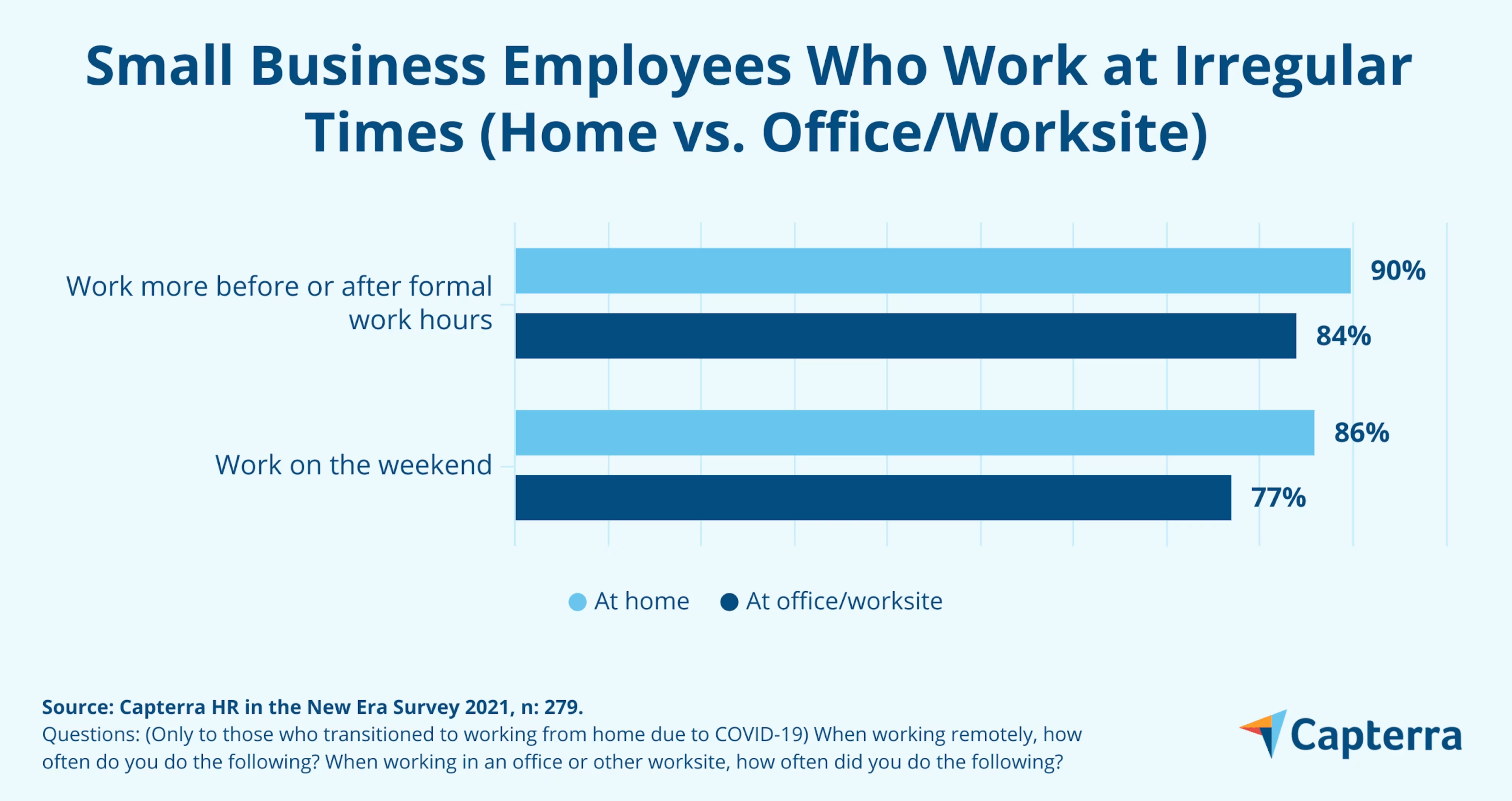
The line between work life and home life has been blurred more than ever over the past year, and workers—especially younger workers—are struggling.
Making matters worse, a significant chunk of these burned out workers are struggling in silence. When asked if they’ve discussed their mental health and wellbeing with their employer since the COVID-19 pandemic began, 36% of those experiencing burnout say they haven’t.
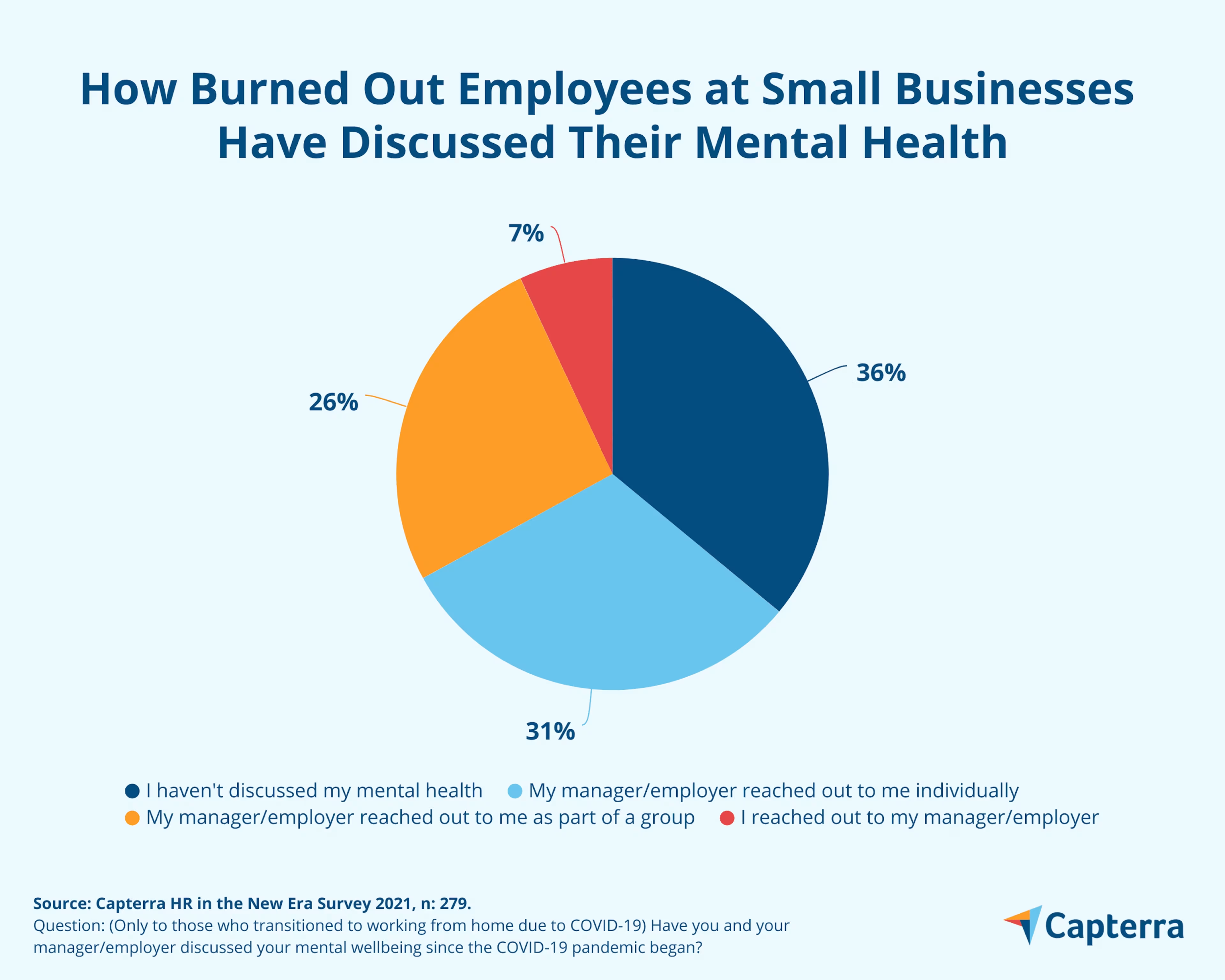
It is past time for small businesses to address the causes of burnout in their organization, proactively reach out to their most affected workers, and improve their mental health resources.
What small businesses should do now
Though the pandemic itself has been a stressor for many, that doesn’t completely absolve small businesses of burnout blame. The transition to working from home has led many employees to overwork themselves more than ever. Managers and HR leaders need to make a concerted effort to provide real relief, or watch their post-pandemic workforce continue to struggle.
Here’s how you can successfully address employee burnout in your organization:
Know what the symptoms of burnout look like. Not every sign of burnout is obvious, and if you’re able to catch burnout early enough, you can intervene before it gets worse. For help here, check out “5 Employee Burnout Signs You’re Not Catching.”
Implement multiple ways for employees to talk about issues. Employees aren’t always comfortable discussing their mental health with their manager. Implementing different avenues for workers to bring up burnout concerns (one-on-one meetings, anonymous surveys, employee assistance programs, etc.) can ensure every worker can be heard. We offer tips on how to get employees to open up about burnout here.
Give workers a break. More than anything, burned out employees just want more time off. Give them more paid time off (PTO), and encourage them to use it. If you can’t, at least put in hard time stops for tasks like answering emails and encourage everyone from the CEO down to abide by them to break away from a culture of overworking.
Trend #4: The ever-widening skills gap
What’s happening?
The skills gap—the gap between the skills employees have and the ones businesses need to succeed—was already a big talking point before the pandemic. A study by SHRM in 2019 found that 83% of recruiters were having difficulties finding suitable job candidates with the necessary skills, with a majority saying the skills shortage had grown worse in the past two years.
As businesses struggled to stay afloat in 2020, skills development took a backseat. When asked if they have developed any new work skills during the COVID-19 pandemic so far, almost half (49%) of small business employees say they haven’t.
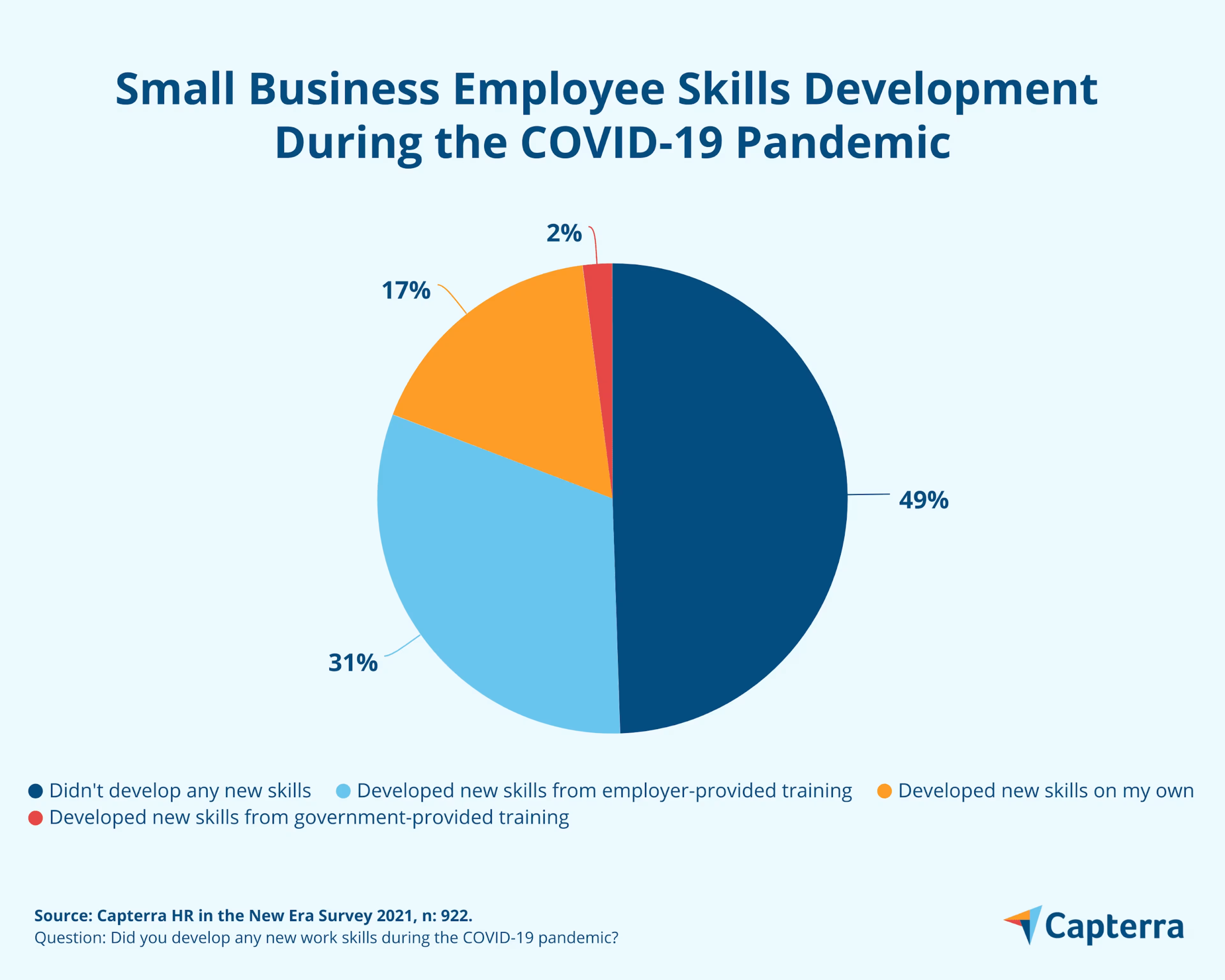
In opposition to the burnout trend above, this lack of skills development is happening more with older workers, especially those 55 and above—a growing segment of the workforce, and one that has gotten a quarter of the training younger workers get, according to the most recent study on the aging workforce from the U.S. Senate.
Age Group | % Developing No New Skills |
18-25 (n=147) | 26% |
26-35 (n=200) | 37% |
36-45 (n=268) | 53% |
46-55 (n=164) | 64% |
56-65 (n=143) | 69% |
Those employees that have learned skills during the pandemic didn’t necessarily learn the skills small businesses need either. Here’s a comparison of the top five skills small business employees said they’ve developed during COVID-19 with the top five skills small business leaders anticipated needing over the next six months back in August:
Top 5 Skills Developed During Pandemic (n=466) | Top 5 Skills Small Business Leaders Anticipate Needing (n=577) |
1. Basic computer and software skills (38%) | 1. Network management (38%) |
2. Web and app development (25%) | 2. Web and app development (30%) |
3. Cybersecurity (20%) | 3. Social media marketing (29%) |
4. Sales skills (17%) | 4. Project management (25%) |
5. Communication and presentation skills (15%) | 5. Cybersecurity (23%) |
While skills like web and app development and cybersecurity are aligning with small business expectations, other skills needs like project and network management haven’t been addressed. Bottom line: The skills gap among the post-pandemic workforce is only growing wider. Small businesses should pay attention.
What small businesses should do now
With small businesses spending an average of $1,678 per learner on training last year, skills development can certainly be an expensive project to take on. But it doesn’t have to be. Here are some things you can do to address your company’s skills gaps without breaking the bank:
Perform a skills gap analysis. Where is the skills gap most prominent in your organization, and with which workers? Using just a bit of math and an Excel spreadsheet, you can find out.
Make use of mentorships. If a handful of workers have a skill you could use more of, spread the wealth and set up mentorships between those that have the skills you need with those that lack them. There are even software systems to help out with this and better engage employees in mentorship programs.
Look into free and open source training software systems. Though they may lack the sophistication and upper limits of a paid solution, free and open source learning management systems (LMSs) can still provide everything a small business needs to promote more skills development. We’ve listed the top 11 options here.
Trend #5: Gen Z is overwhelmed with work tools
What’s happening?
There’s no doubt that technology has played a vital role in the transition to remote work over the past year. Despite all the “Zoom fatigue” and the stress of having to learn new apps and systems, this transition simply wouldn’t have been possible for a large chunk of the U.S. workforce even 10 years ago.
But there’s a downside to all of this digitization, and it’s showing up most prominently in Gen Z. In short, they’re overwhelmed by too many digital work tools.
When asked how many digital tools they use for different aspects of their work, a majority of small business employees aged 18 to 25 say they use multiple tools for everything from personal organization, to storing files, and even learning and development. A clear pattern has emerged that the younger a worker is, the more likely they are to use multiple digital tools at work.
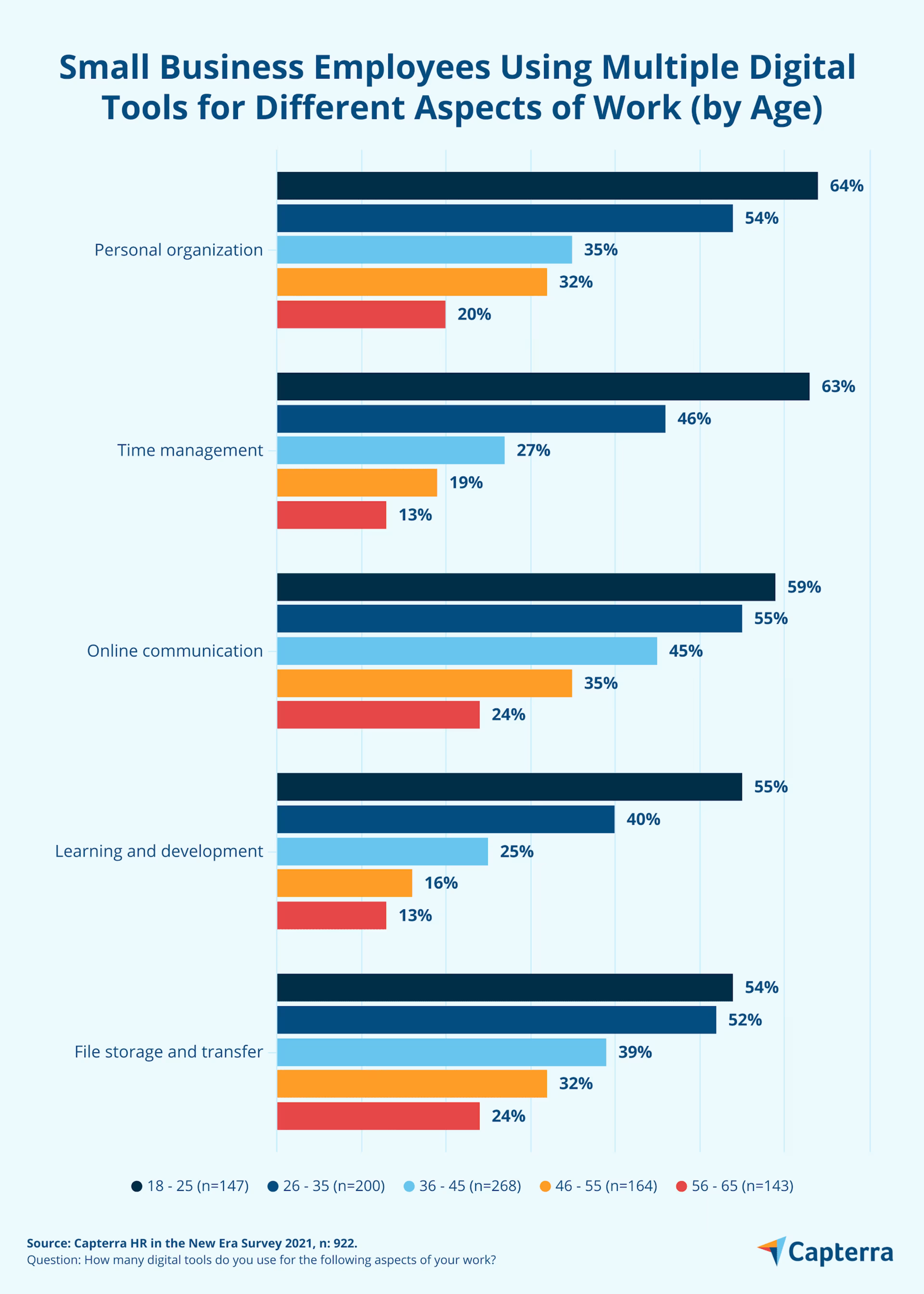
Being the “digital natives” that they are, it’s not that surprising that Gen Z would gravitate to, and be more comfortable with, using digital tools at work. But the more tools these workers take on, the more passwords they have to juggle, and the more user interfaces they have to learn and remember how to navigate. Is it becoming too much? Our data suggests it is.
When asked how overwhelmed they are by the amount of tools they’re using for work, nearly three in four Gen Z workers (71%) say they are at least a bit overwhelmed—the highest percentage among the age groups we surveyed.
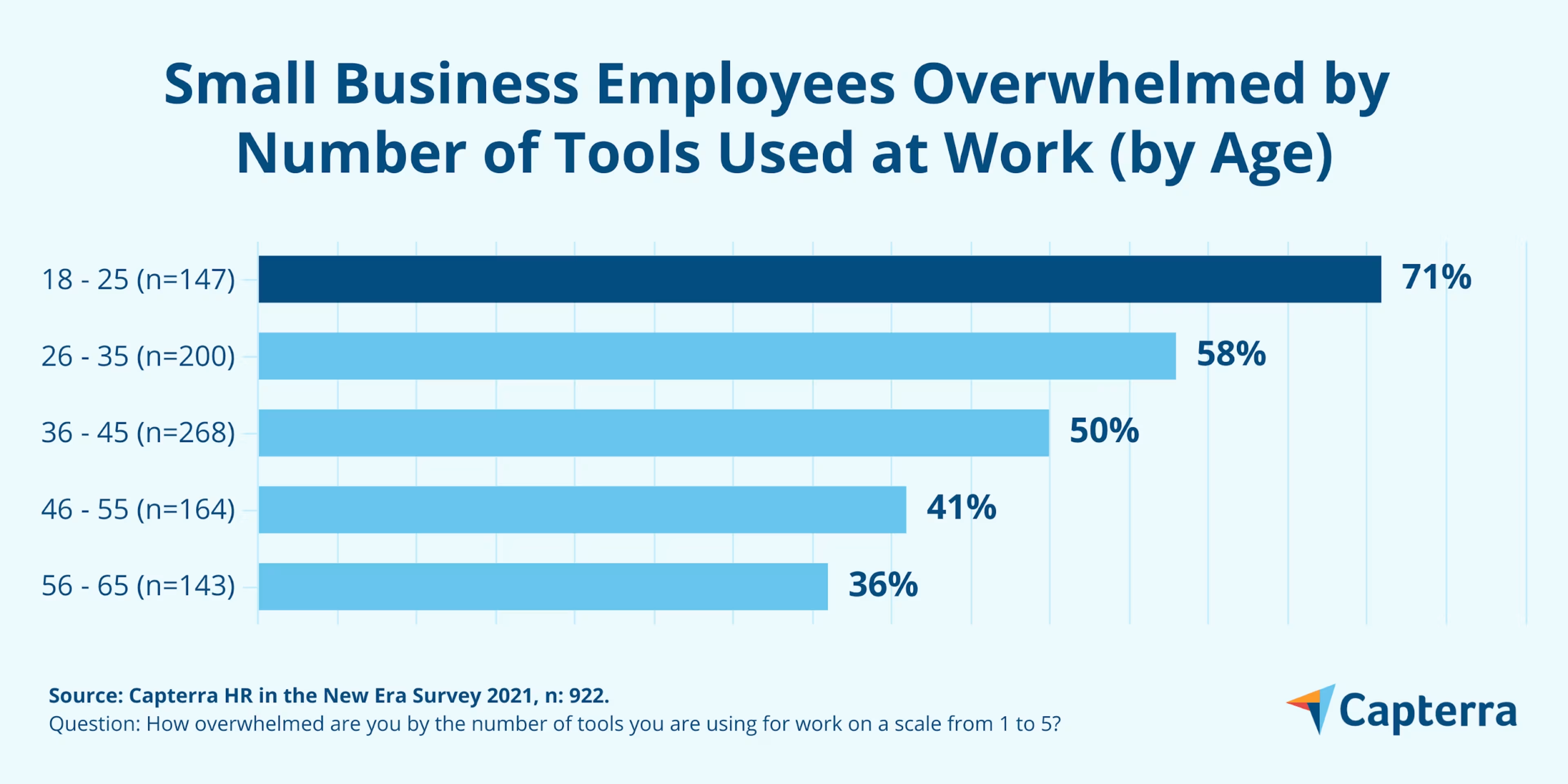
As small businesses continue to digitize how they operate, small business leaders will need to be more thoughtful with what tools they implement and how they implement them to avoid overwhelming their youngest workers.
What small businesses should do now
There’s actually a term for the software burnout Gen Z is currently experiencing: “technostress.” The dangers with technostress for small businesses moving forward is real: If workers are overcome by it, every new tool you purchase to make your workforce more productive and efficient will be used less and less effectively.
To ensure every tool is used to its maximum potential, here is some advice on how to help young workers avoid technostress.
Do a technology audit of your business. The main goal of this audit is to discover any overlap between the various tools your employees are using. If multiple tools serve the same purpose, it could be time to scrap one of them.
Invest in a password manager. Part of the stress with so many digital tools is remembering so many passwords. With a password manager, workers only need to remember one master password to access every tool in the business. (You can check out some top-rated password managers here.)
Don’t roll out every feature at once. Though it’s tempting to throw everything a new tool offers at your workers all at once, a staged rollout starting with the most necessary features is better for helping employees to become comfortable with the system.
For additional tips, check out “Is Technostress Burning Out Your Workforce? 5 Things to Do About It.”
There’s more where that came from
Where will small businesses be five years from now? What about 50? Though it can be stressful to think about all of the changes that lie ahead—especially after a year that was almost entirely defined by change—this is more than just a thought exercise. The more we can accurately predict now, the better prepared you will be. Embrace the opportunity.
We're big fans of making data-driven predictions here at Capterra. If you are too, we highly recommend you check out these additional articles.
